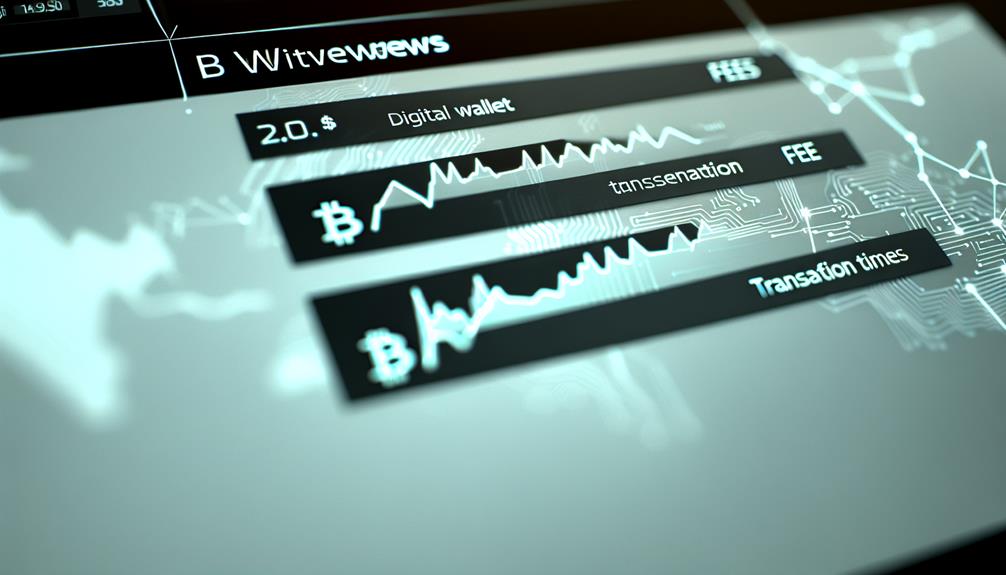You might not realize that the process of withdrawing Bitcoin can vary greatly depending on your chosen method. It's crucial to understand how different platforms and services handle transactions, including potential fees and security measures. Once you know the nuances, you'll be better equipped to make informed decisions about converting your Bitcoin or transferring it to another wallet. So, what are the key factors you should consider to guarantee a smooth withdrawal process?
Understanding Bitcoin Wallets
Understanding Bitcoin wallets is vital for anyone looking to withdraw and manage their cryptocurrency effectively. A Bitcoin wallet serves as a digital tool that allows you to send, receive, and store your Bitcoin securely. Familiarizing yourself with the various wallet types is important in ensuring the best wallet security, which is a primary concern for any cryptocurrency user.
There are several wallet types to take into account. Hardware wallets, for instance, are physical devices that store your private keys offline, offering robust protection against hacking. On the other hand, software wallets, which can be desktop or mobile applications, provide convenience for daily transactions but require a higher degree of security scrutiny. Additionally, web wallets, often provided by exchanges, offer instant access but can be vulnerable to online threats. Each wallet type has its benefits and trade-offs, and understanding these will help you make informed decisions based on your usage and risk tolerance.
Wallet security is paramount in the crypto space. Using strong passwords, enabling two-factor authentication, and keeping your software updated are essential practices to safeguard your assets. Furthermore, it's advisable to back up your wallet regularly and think about using multi-signature wallets for added security. Ultimately, the right balance between convenience and security will determine how effectively you can manage and withdraw your Bitcoin. By understanding wallet types and prioritizing wallet security, you'll be better equipped to navigate the cryptocurrency landscape.
Choosing a Withdrawal Method
When it comes to withdrawing Bitcoin, selecting the right method is essential for guaranteeing a smooth and secure transaction. You have several withdrawal options available, each with its own set of advantages and limitations. Understanding these options can help you navigate the process effectively and avoid potential pitfalls.
Here's a comparison of three common withdrawal methods:
| Method | Advantages | Considerations |
|---|---|---|
| Bank Transfer | Direct deposit to your account | May have higher transaction limits |
| Crypto Exchange | Quick access to funds | Fees may apply on withdrawals |
| ATM Withdrawal | Immediate cash access | Limited availability and often higher fees |
Before you decide, consider the transaction limits associated with each method. For example, bank transfers often have higher limits, making them ideal for larger withdrawals. Conversely, ATM withdrawals might restrict you to smaller amounts per transaction.
Additionally, assess the fees involved. Some methods may charge flat fees, while others might take a percentage of the transaction. Be sure to read the fine print on your chosen platform to understand these costs fully.
Ultimately, your choice will depend on factors such as urgency, amount, and personal preferences. By analyzing your options carefully, you can guarantee that your Bitcoin withdrawal aligns with your financial needs, providing both security and convenience in the process.
Converting Bitcoin to Cash

Typically, converting Bitcoin to cash involves a series of steps that require careful consideration to guarantee a smooth transaction. Understanding the various Bitcoin selling strategies and cash withdrawal options can help you maximize your returns while minimizing risks.
First, you'll need to choose a platform for selling your Bitcoin. Here are three common options:
- Cryptocurrency Exchanges: Platforms like Coinbase or Binance allow you to sell Bitcoin for cash directly. You'll need to create an account, verify your identity, and link your bank account for withdrawals.
- Peer-to-Peer Platforms: Websites like LocalBitcoins enable you to sell Bitcoin directly to other individuals, often allowing for a wider range of payment methods. This can offer better rates but requires trust in your buyer.
- Bitcoin ATMs: These machines allow you to sell Bitcoin for cash on the spot. While convenient, fees can be higher than other methods, so it's crucial to check the rates before proceeding.
Once you've selected a method, you'll execute the sale by placing an order and following the platform's instructions. After selling, make sure to choose a reliable cash withdrawal option that suits your needs. Always consider transaction fees, withdrawal limits, and processing times when making your decision.
Transferring Bitcoin to Another Wallet
When transferring Bitcoin to another wallet, you first need to choose the appropriate wallet type—be it hardware, software, or online. Next, generate a receiving address from the destination wallet to guarantee your Bitcoin is directed correctly. Finally, initiate the transfer by inputting the amount and the receiving address into your wallet's interface.
Choose Your Wallet Type
Choosing the right wallet type is essential for securely transferring Bitcoin to another wallet, and you have several options to evaluate. Each type has its own benefits and risks, so understanding them will help you make informed decisions.
- Hardware Wallets: These physical devices offer high security by storing your private keys offline. They're ideal for long-term storage but can be less convenient for frequent transactions.
- Software and Mobile Wallets: Software wallets run on your computer or mobile device, providing ease of access. Mobile wallets, in particular, allow you to transact on-the-go but may expose you to online threats.
- Exchange and Custodial Wallets: These wallets are managed by third-party services. While they're user-friendly, you're trusting the provider to secure your funds. Non-custodial wallets, on the other hand, give you full control over your private keys.
You might also consider paper wallets for offline storage or multi-signature wallets, which require multiple approvals for transactions, enhancing security. Ultimately, the best choice depends on your specific needs, such as accessibility, frequency of transactions, and security preferences.
Generate Receiving Address
After selecting the appropriate wallet type, the next step in transferring Bitcoin is generating a receiving address. This address is vital for the transaction, as it guarantees that your Bitcoin is sent to the correct destination. When creating addresses, it is important to take into account the type of wallet you're using, as different wallets may have unique processes or formats.
Generating a receiving address is typically straightforward. Most wallets will provide an option to create a new address with a simple click. However, keep in mind that using the same address repeatedly can raise privacy concerns. To enhance privacy, it is recommended to generate a new receiving address for each transaction.
Here's a quick reference table regarding address generation:
| Wallet Type | Address Format |
|---|---|
| Software Wallet | P2PKH (Bitcoin) |
| Hardware Wallet | P2SH (Pay to Script Hash) |
| Custodial Wallet | SegWit (Bech32) |
Initiate the Transfer
To initiate the transfer of Bitcoin to another wallet, you'll first need to access the send or transfer function within your chosen wallet interface. This step is essential in your withdrawal process, as it allows you to specify the amount of Bitcoin you wish to send and the recipient's wallet address.
Follow these steps to guarantee a smooth transfer:
- Enter the Recipient's Address: Carefully paste or type the receiving address you generated in the previous step. Double-check for accuracy, as sending to the wrong address can result in permanent loss of your funds.
- Specify the Amount: Decide how much Bitcoin you want to transfer. Consider any network fees that might apply, as these can affect the total amount received by the recipient.
- Review and Confirm: Before finalizing the transaction, review all details. Confirm that the address and amount are correct. Once you're confident, proceed to initiate the transfer. After submission, wait for the transfer confirmation, which typically occurs after a few network confirmations.
Fees and Transaction Times

When withdrawing Bitcoin, understanding the associated fees and transaction times is vital for effective financial planning. Transaction fees can vary greatly based on network congestion and the platform you're using. These fees are typically calculated in satoshis per byte, meaning that the size of your transaction in bytes directly impacts the total cost. If the Bitcoin network is experiencing high demand, you might face elevated transaction fees, so timing your withdrawal can save you money.
Additionally, many exchanges impose withdrawal limits, which can affect how much Bitcoin you can take out at one time. These limits can differ based on your account verification level, with unverified accounts often facing stricter withdrawal restrictions. It's important to review these limits beforehand to avoid unexpected delays in accessing your funds.
Transaction times also vary based on network activity and the fees you're willing to pay. Generally, transactions can take anywhere from a few minutes to several hours. A higher transaction fee usually results in faster confirmation, as miners prioritize transactions that offer greater rewards. As a result, if you need your Bitcoin quickly, consider adjusting your fee to reflect that urgency.
Security Considerations
Withdrawing Bitcoin involves not just understanding fees and transaction times but also implementing robust security measures to protect your assets. Security is paramount, as the decentralized nature of cryptocurrencies means that you bear full responsibility for safeguarding your funds. Here are three critical considerations to keep in mind:
- Wallet Security: Choose a reputable wallet that offers strong encryption and security features. Hardware wallets are often recommended for long-term storage due to their offline nature, reducing the risk of hacks.
- Private Key Management: Your private key is the gateway to your Bitcoin. Never share it, and consider storing it in a secure location, separate from your wallet. Using a mnemonic phrase can help you recover your wallet if needed, but make sure that this phrase is also kept private and secure.
- Phishing Awareness & Two-Factor Authentication: Be vigilant against phishing attempts, as scammers often impersonate legitimate services to steal your credentials. Enable two-factor authentication (2FA) on your wallet and exchange accounts for an additional layer of security. This requires you to verify your identity with a second device, making unauthorized access much more difficult.
Frequently Asked Questions
Can I Withdraw Bitcoin Anonymously?
Yes, you can withdraw Bitcoin anonymously by using anonymous wallets, which help mitigate privacy concerns. However, be aware that complete anonymity is challenging due to blockchain transparency and potential regulatory scrutiny. Always prioritize security when transacting.
What Happens if I Enter the Wrong Withdrawal Address?
Entering the wrong withdrawal address is like sending a letter to the wrong mailbox; your funds could vanish. Always prioritize withdrawal security by ensuring address verification to avoid potential losses and irreversible transactions.
Are There Withdrawal Limits on Exchanges?
Yes, most exchanges have withdrawal limits as part of their withdrawal policies. These limits can vary based on your verification level and may include exchange fees that you should consider when planning your transactions.
How Long Does It Take to Withdraw Bitcoin?
When you're considering withdrawal times, remember that factors like withdraw processing times and blockchain confirmation delays can affect your experience. Typically, it takes anywhere from minutes to hours, depending on network congestion and exchange policies.
Can I Withdraw Bitcoin to a Prepaid Card?
Yes, you can withdraw Bitcoin to a prepaid card, but options vary. Be mindful of transaction fees associated with conversions, as they can affect your overall balance. Research providers for the best prepaid card options available.
Conclusion
In summary, withdrawing Bitcoin involves careful consideration of your wallet, withdrawal method, and security measures. Notably, as of 2023, around 25% of Bitcoin transactions are conducted via ATMs, highlighting their growing popularity. By understanding the nuances of conversion and transaction fees, you can optimize your withdrawal process. Always prioritize security practices to protect your funds, ensuring a smooth shift whether you're cashing out or transferring assets. Stay informed to navigate the evolving cryptocurrency landscape effectively.
